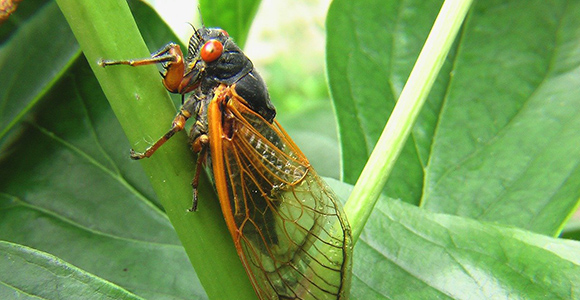The 17-year and 13-year cicadas are not supposed to arrive in certain parts of the country until next year - but a few are crashing the party early.

CINCINNATI – Some winged, red-eyed bugs are simultaneously popping up a year early across a number of Midwestern and Southern states, exciting scientists and followers of the periodical broods.
Dr. Gene Kritsky, dean of Behavioral and Natural Sciences at Mount St. Joseph University in Cincinnati said he continues to receive reports of the early cicada emergence of Brood XIII, a 17-year cicada, and Brood XIX, a 13-year cicada.
“There are not a lot of cicadas emerging, and this year is not a full emergence of either brood,” Dr. Kritsky said. “That will happen in 2024. But some are coming up early, so we are asking people to be on the lookout for cicadas in a number of states."
Brood XIII cicadas are expected next year in northern Illinois including the Chicago area; far eastern Iowa; and a sliver of northeastern Indiana, including the Gary, Ind., area.
Brood XIX cicadas are expected in southern Illinois; Missouri, including the St. Louis area; northern and southern Arkansas; middle Tennessee; northern Louisiana; central and Mississippi, Alabama and Georgia, including the Columbus, Ga., area; northern and central South Carolina; and central North Carolina, including the Durham area.
"We have been mapping periodical cicadas for the past three years,” Dr. Kritsky said. "Last year, we did the unusual and made a concerted effort to look for cicadas when we did not expect any to emerge. We found that a few periodical cicadas emerged in 15 states and the District of Columbia.”
But just as last year, all of these early bugs will be eaten by birds and other predators not reproducing.
“Predators should consider these early cicadas to be hors d'oeuvres compared to the massive emergence expected in 2024," Dr. Kritsky said.
Anyone with a Smartphone can become a citizen scientist and track, map, photograph and video through Mount St. Joseph University's hugely popular Cicada Safari app, which can be downloaded from the Apple App Store or Google Play.
Cicada Safari has been downloaded more than 200,000 times and users have submitted over 551,000 periodical cicada photos.
"We developed this app because so many people are fascinated by periodical cicadas," said Dr. Kritsky, who has studied, tracked and written about cicadas throughout his academic career. "This is true citizen science. The photographs and videos submitted to our map are like voucher specimens permitting us to verify the observations, making the maps more useful for future research."
Cicada Safari users will contribute to vital scientific research by determining the distribution of the emerging cicadas, enabling scientists to assess the status of cicadas. The app was first tested in 2019 and 2020 with smaller broods and has proven to be an effective mapping and tracking tool.
A recognized cicada expert, Dr. Kritsky has given hundreds of media interviews, published academic papers on cicadas and is the author of two books on cicadas.
Following are some cicada facts from the Cicada Safari.org website:
- Cicadas emerge after the soil temperature exceeds 64 degrees, which is usually in mid May.
- Only male cicadas sing through sound-producing structures called tymbals on either side of the abdomen under the wings.
- Cicadas do not eat solid food but do drink fluids to avoid dehydration.
- Cicadas do not sting or bite, and do not carry diseases.
- Periodical cicada years are quite beneficial to the ecology of the region. Their egg-laying in trees is a natural pruning that results in increased numbers of flowers and fruits in the succeeding years. Their emergence from the ground turns over large amounts of soil, and after they die their decaying bodies contribute a massive amount of nutrients to the soil.
- Periodical cicadas are often incorrectly called locusts. Locusts are grasshoppers and cicadas are more closely related to aphids than grasshoppers.
About the Mount St. Joseph University
As a Catholic institution rooted in the values of the Sisters of Charity, Mount St. Joseph University excels at serving the common good. Undergraduate, graduate, and doctoral students at the Mount are inspired to think beyond the classroom and redraw the bounds of what’s possible for their futures. This is accomplished through individualized educational experiences, a safe, secure campus environment, and an all-in commitment from faculty and staff to seeing students reach their highest potential. The Mount fosters life-long learners who serve, care, and contribute to the world beyond their front doors.
###

